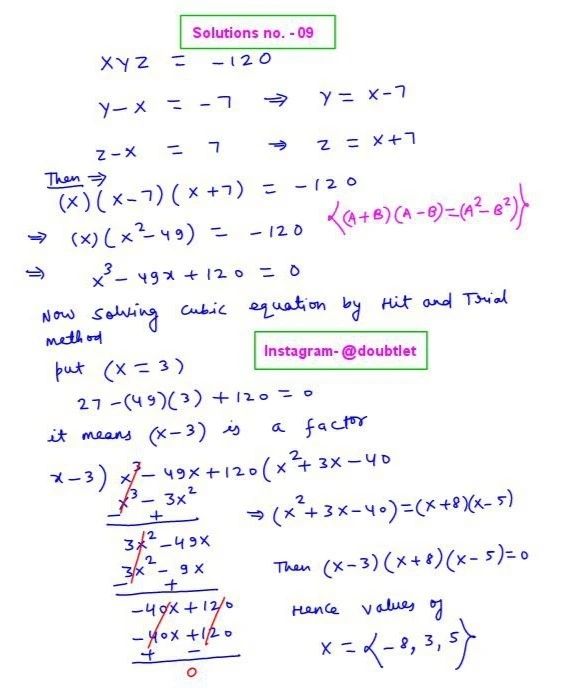









The inverse of a function reverses the operation of the original function. If a function maps to , the inverse function, denoted , maps back to . A function must be one-to-one (bijective) to have an inverse, meaning each output has a unique input, and its graph is symmetrical along the line .

Neetesh Kumar | September 22, 2024
Share this Page on:
![]()
![]()
![]()
![]()
![]()
- 1. Introduction to the Inverse of a Function
- 2. What is Inverse of a Function
- 3. How to find the Inverse of a Function
- 4. Rules for Inverse of a Function
- 5. Properties of Inverse of a Function
- 6. Inverse of a Function Solved Examples
- 7. Practice Questions on Inverse of a Function
- 8. FAQs on Inverse of a Function
- 9. Real-life application of Inverse of a Function
- 10. Conclusion
1. Introduction to the Inverse of a Function:
Understanding the inverse of a function is essential in advanced mathematics, especially in calculus and algebra. The inverse function essentially "reverses" the effect of the original function. For example, if a function transforms an input into an output, the inverse function returns the output to the original input. This concept is crucial in solving equations, analyzing graphs, and understanding real-life applications.
2. What is the Inverse of a Function:
An inverse function is a function that undoes the action of the original function. If a function maps to , then the inverse function maps back to .
Mathematically, if:
Then the inverse is:
For a function to have an inverse, it must be bijective. It must be both one-to-one (injective) and onto (surjective). This means every output value has a unique input value, and every possible output must be covered.
3. How to Find the Inverse of a Function:
To find the inverse of a function, follow these steps:
-
Replace with :
Begin by rewriting the function in terms of . For example, if , write: -
Swap and :
To find the inverse, interchange the variables: -
Solve for :
Now, solve for : -
Rewrite the inverse function:
The inverse of is:
4. Rules for Inverse of a Function:
Certain rules must be followed when dealing with inverse functions:
- One-to-One Requirement: A function must be one-to-one to have an inverse, meaning no two different inputs should map to the same output.
- Horizontal Line Test: A function passes the horizontal line test if no horizontal line intersects its graph more than once. This indicates the function is one-to-one and has an inverse.
- Symmetry: The graph of a function and its inverse are symmetrical along the line . Inverse functions reflect across this line.
5. Properties of Inverse of a Function:
Inverse functions have several important properties:
-
Composition Property: If and are inverses, then: and
-
Domain and Range: The original function's domain becomes the inverse function's range, and vice versa.
-
Inverse of Linear Functions: For a linear function , the inverse will be another linear function , provided .
-
Inverse of Exponential and Logarithmic Functions: Exponential and logarithmic functions are inverses. For example: and In
6. The inverse of a Function Solved Examples:
Question: 1
Find the inverse of
Solution:
Step 1: Replace with :
Step 2: Swap and :
Step 3: Solve for :
Final Inverse Function:
Question: 2
Find the inverse of
Solution:
Step 1: Replace with :
Step 2: Swap and :
Step 3: Solve for :
Multiply both sides by :
Add to both sides:
Divide by :
Final Inverse Function:
Question: 3
Find the inverse of
Solution:
Step 1: Replace with :
Step 2: Swap and :
Step 3: Solve for :
Subtract from both sides:
Divide by :
Take the cube root of both sides:
Final Inverse Function:
Question: 4
Find the inverse of
Solution:
Step 1: Replace with :
Step 2: Swap and :
Step 3: Solve for :
Take the natural logarithm of both sides: In
Final Inverse Function: In
Question: 5
Find the inverse of
Solution:
Step 1: Replace with :
Step 2: Swap and :
Step 3: Solve for :
Multiply both sides by :
Subtract from both sides:
Now, divide by :
Final Inverse Function:
7. Practice Questions on Inverse of a Function:
Q.1 Find the inverse of the function .
Q.2 Determine if the function has an inverse.
Q.3 Find the inverse of .
Q.4 Verify if is the inverse of .
Q.5 Graph and determine if it has an inverse.
8. FAQs on Inverse of a Function:
How do I know if a function has an inverse?
A function has an inverse if it is one-to-one, meaning it passes the horizontal line test.
What is the inverse of a quadratic function?
Not all quadratic functions have inverses because they are not one-to-one. However, restricting the domain can make some quadratic functions invertible.
What is the use of an inverse function?
Inverse functions are used to reverse mathematical processes, solve equations, and model real-world situations where an input needs to be retrieved from an output.
How can I graph an inverse function?
To graph an inverse function, reflect the original function's graph across the line .
Why is the inverse of a function important?
Inverse functions allow us to "undo" the operation of a function, helping in algebra, calculus, and real-world applications like encryption, physics, and engineering.
Do all functions have inverses?
No, only one-to-one functions have inverses. Functions that map multiple inputs to the same output do not have inverses.
What is the relationship between a function and its inverse?
The function and its inverse are reflections of each other across the line , and their compositions always return the input value.
9. Real-Life Application of Inverse of a Function:
Inverse functions have a variety of practical applications across different fields:
- Cryptography: Inverse functions are used in encryption algorithms to encode and decode messages.
- Physics and Engineering: Inverse functions help model systems where you must reverse a process, such as converting energy to force or time to velocity.
- Economics: Inverse functions can reverse supply-demand models or calculate inverse relationships between variables like price and quantity.
For example, in navigation, if you know the distance a vehicle traveled (output), using the inverse of the speed function helps find the time (input).
10. Conclusion:
The inverse of a function is a fundamental concept in mathematics, allowing us to reverse the effects of a function and solve various types of problems. It requires the function to be one-to-one and provides insight into the structure of mathematical models, equations, and real-life phenomena. Understanding how to find and work with inverses opens doors to advanced problem-solving techniques in algebra, calculus, and applied fields.
If you have any suggestions regarding the improvement of the content of this page, please write to me at My Official Email Address: [email protected]
Are you Stuck on homework, assignments, projects, quizzes, labs, midterms, or exams?
To get connected to our tutors in real time. Sign up and get registered with us.
Function Formula Sheet
Limit Formula Sheet
Linear Algebra Calculators
Evaluate function value Calculator
Average rate of Change Calculator
Blog Information
Blog Author: Neetesh Kumar
Blog Publisher: Doubtlet
Comments(0)
Your comment will be reviewed before it is published.



Leave a comment